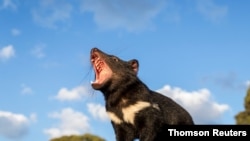Tasmanian devils are back Down Under for the first time in thousands of years, thanks to a reintroduction project that released a group of the feisty marsupials in Barrington Tops, a protected national park about 200 kilometers north of Sydney.
Eleven devils were freed Tuesday to roam mainland Australia; they are the first of their kind to do so in nearly 3,000 years. Their population was at least partially wiped out by dingoes, wild dogs that were introduced to the Outback at least 3,500 years ago. Ecologists say that a surge in the indigenous human population and a severe drought caused by a prolonged El Nino also contributed to their elimination from the mainland.
The only remaining devils prior to Tuesday’s release were on the island of Tasmania, where they found refuge from dingo populations. However, the scavengers have struggled with a deadly and highly infectious cancer called Devil Facial Tumor Disease. The cancer has spread through the population through biting, fighting and mating, according to Aussie Ark, a conservation group that aided in the reintroduction program.
The fierce creatures were listed as endangered on the United Nations Red List in 2008, with only 2,500 left in the wild.
Tasmanian devils, though no larger than a small dog, are the world’s largest surviving marsupial carnivore. Despite being small in stature, the creatures made a big splash because of their frenzied, raucous habits showcased by the character Taz in the Looney Tunes cartoons.
Over the course of a decade, ecologists worked to clear out the dingo population — now considered a pest species — from Barrington Tops. They began breeding the devils in captivity, hoping to one day return them to the mainland once conditions were sustainable for survival.
Experts from Aussie Ark, Global Wildlife Conservation (GWC) and WildArk said they hope that bringing back the devils will help protect other native species that have been threatened by invasive predators, according to a statement released Oct. 5 by GWC.
Researchers said in the statement that each devil released into the Australian wild has been tested for the cancer that nearly wiped out the population living in Tasmania. It is their hope that the cancer-free devils will boost the ecosystem that has been ravaged by feral cats and foxes.
The devils, 20 more of which are expected to be released in the next year, are being kept in a protected 404-hectare wildlife sanctuary, where they will be monitored by remote cameras and GPS tags to gauge how they adjust to their new environment.










